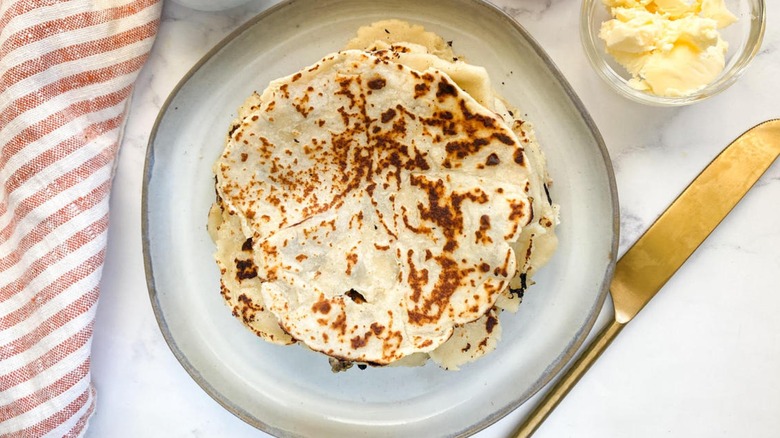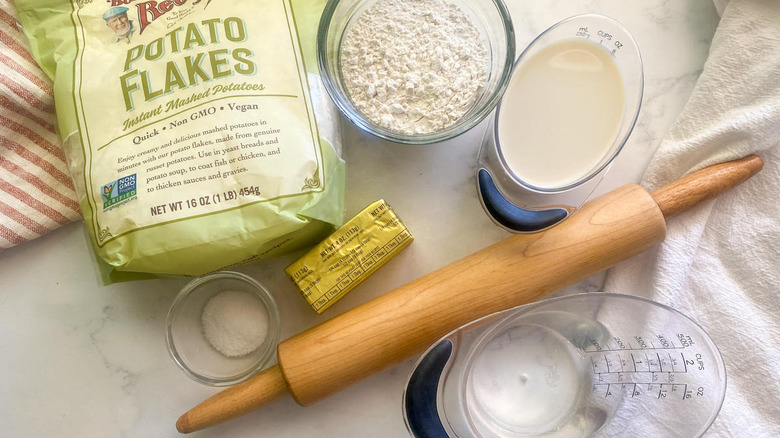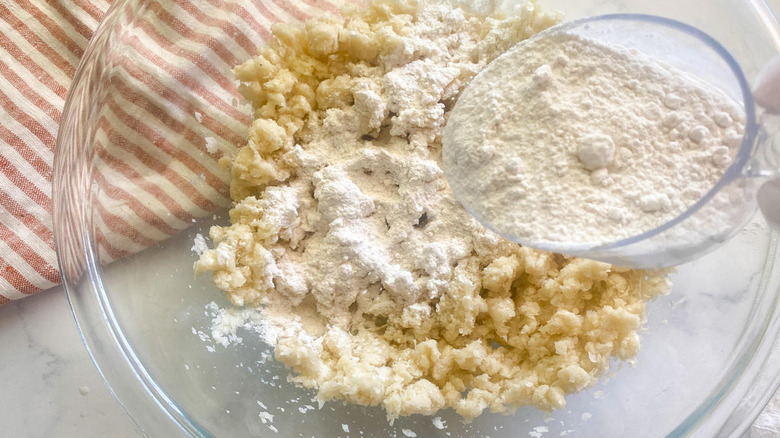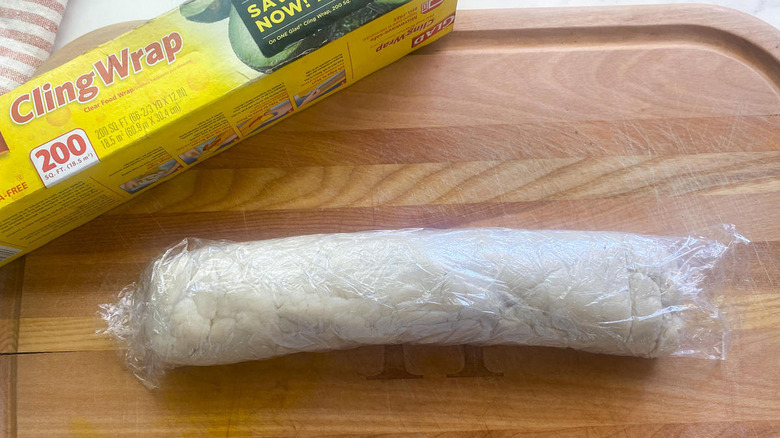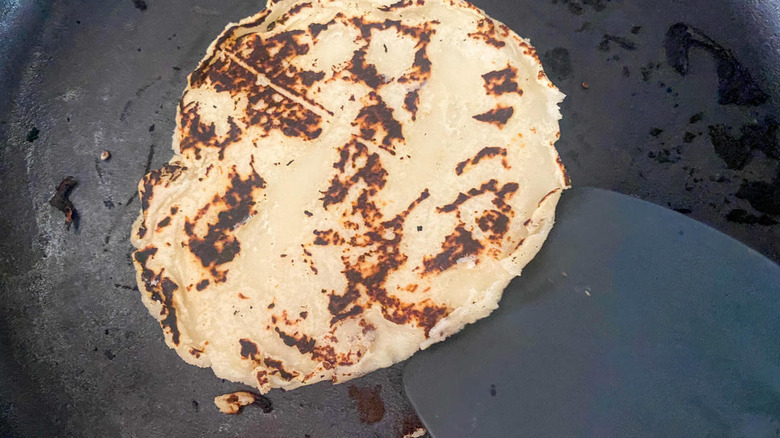Simple Norwegian Lefse Recipe
Scandinavian lefse is a traditional Norwegian-style potato flatbread that could be considered the region's version of a tortilla, or, as recipe developer Miriam Hahn describes it, a "doughy, moist pita bread" (only without the pocket). Lefse is typically made with fresh potatoes, and making it using the traditional method can be kind of a hassle as it's not all that easy to get the dough just right. Here, however, Hahn uses mashed potato flakes: "They save a huge step and really simplify this recipe."
Lefse, on their own, don't have a great deal of flavor since they are primarily composed of flour and potatoes, but they're typically eaten with butter and maybe with jelly or a sprinkle of sugar. Hahn also suggests serving them with peanut butter or honey and says they can also be used to make wrap sandwiches. You could even use them for gyros or tacos -– think Scandinavian fusion!
Gather the ingredients for Norwegian lefse
Apart from the potato flakes, the rest of the lefse ingredients are basic staples. You'll be using flour and salt from the pantry, water from the tap, and milk and butter from the fridge.
Make the lefse dough
Heat the water, butter, and salt in a pot over medium heat. Once the mixture starts to boil, turn off the stove. Stir in the milk, then pour this mixture into a bowl with the potato flakes. Stir it up, then knead in the flour, 2 tablespoons at a time.
Chill and form the lefse
Take the dough and form it into a cylinder, about 10 inches long. Wrap the log in plastic and stick it in the refrigerator for 30 minutes. Once the dough is chilled, unwrap it and slice it into 20 equal-sized pieces. Flatten each piece into a circle on a piece of waxed or parchment paper. Top the paper with another piece, then roll the lefse until it's as thin and flat as you can get it (as long as the resulting circle still fits in the pan).
Cook the lefse
Heat up an ungreased cast iron skillet or an electric skillet on high, then, when it's hot, take a rolled piece of lefse and put it in the pan. Using a fork, knife, or spatula, lift it up around the edges to ensure it doesn't stick. After 40 to 50 seconds, check to see if the underside of the lefse has charred or brown spots. If so, flip it and cook it for another 30 seconds, or until the other side appears to be similarly charred. Repeat the process for all 20 pieces, storing the cooked lefse under a damp towel as you go.
Hahn does say that the dough can be made in advance, advising that it be wrapped in plastic and stored in the fridge for up to a few days before you slice, roll, and cook. As far as cooked leftovers go, she says to keep them in an airtight container with some paper towels to absorb excess moisture. To reheat them, you can wrap them in a damp paper towel and cook them in the microwave. That way, Hahn says, "they stay nice and moist."
Simple Norwegian Lefse Recipe
This recipe for Norwegian lefse isn't the most traditional, but it will save you some time and effort. The secret? Instant mashed potato flakes!
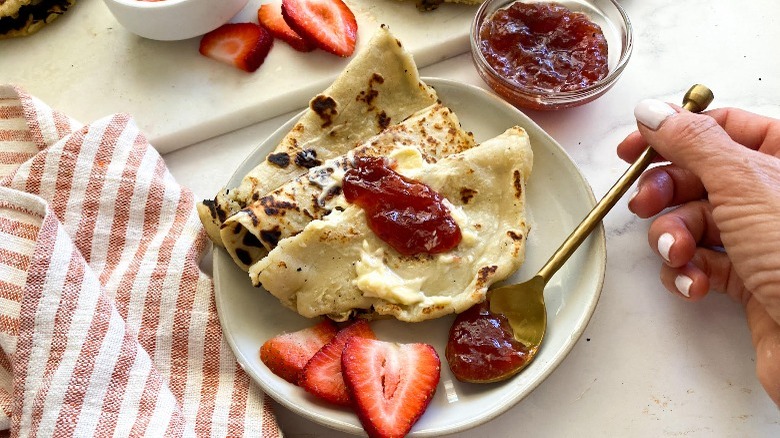
Ingredients
- 1 cup water
- 2 tablespoons butter
- 1 teaspoon salt
- 1 cup milk
- 3 cups potato flakes
- ¾ cup all-purpose flour
Optional Ingredients
- butter, jam, or sugar (for serving)
Directions
- Combine the water, butter, and salt in a pot. Heat over medium.
- Once the mixture comes to a boil, take the pot off the stove and stir in the milk.
- Put the mixture in a bowl and mix in the potato flakes.
- Knead in the flour, 2 tablespoons at a time.
- Form the dough into a 10-inch long cylinder, wrap it in plastic, and refrigerate for 30 minutes.
- Cut the chilled dough into 20 slices.
- Flatten each disc into a circle on a piece of wax or parchment paper, then top with another piece of wax or parchment paper. Roll out the dough between the two sheets until it's as thin as possible.
- Heat a cast iron or electric skillet on high.
- Place a rolled out lefse on the skillet. Lift the edges occasionally so that it doesn't stick to the pan.
- Cook the lefse for 40 to 50 seconds, or until the bottom has some charred, brown spots. Flip it to the other side and cook for another 30 seconds.
- Repeat this process, placing each finished lefse under a damp dishtowel.
- Refrigerate any cooked leftovers in an airtight container with some paper towels to absorb excess moisture.
- Serve with butter, jam, sugar, or any other desired toppings.
Nutrition
| Calories per Serving | 52 |
| Total Fat | 1.6 g |
| Saturated Fat | 1.0 g |
| Trans Fat | 0.0 g |
| Cholesterol | 4.3 mg |
| Total Carbohydrates | 8.1 g |
| Dietary Fiber | 0.6 g |
| Total Sugars | 0.8 g |
| Sodium | 122.5 mg |
| Protein | 1.3 g |
